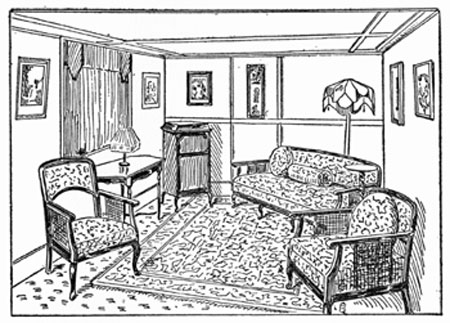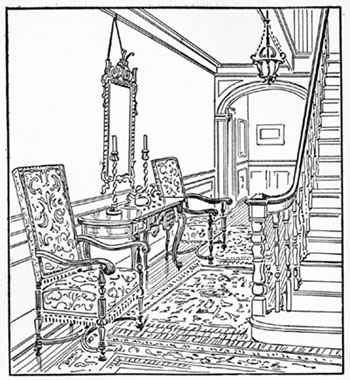The Arrangement of Furniture
The same thing is true of the arrangement of furniture, in direct proportion to the size, bulk and structural emphasis of the individual pieces. While the subject will be discussed in the chapter on balance, it may be noted here that almost invariably the important units in a room-piano, reading table, davenport, bed, dresser, and so forth-must be made to parallel one or the other of the walls, no matter how far away from that wall they may actually stand. The idea that a room can be freed from an effect of stiffness or over- formality and invested with a quality of lightness and personal charm by placing heavy pieces of furniture askew in it is as erroneous as it is widespread.
In the choice of furniture, lamps and pictures the decorator will be guided by the general requirement for congruity in scale. Of course this is not to be interpreted as meaning that every piece of furniture and every textile pattern must be big in a big room, or small in a small room; it means simply that the principal pieces, the really significant objects that together constitute its organic structure, must be of a shape and bulk that is consonant with the shape and size as well as with the purpose of the room, as the thigh or torso of the athlete must be proportioned not only to his height, but also to the requirements of the game in which he is trained to compete. This analogy makes it easy to understand that even in the case of two rooms of the same floor plan a difference in the character of the rooms will necessitate differences in the proportions of many of the decorative units and in their relation to the whole, since it is only through the proportions of its parts that the true character of any whole can be constituted and revealed. Thus in the degree that a drawing room is to express the ideas of animation and gayety, as opposed to those of tranquillity and sobriety, it must be filled with relatively small and light pieces of furniture and decorative objects, even when the room itself is large. In this situation the decorator must depend for the effect of size and bulk necessary to accord harmoniously with the size of the room upon careful grouping. Two light chairs and a small table, for example, grouped for conversation or tea, affect the mind as one rather than as three units, and therefore satisfy the esthetic requirements of consonance, while the small size of the individual pieces accords with the function and decorative motive of the room. The mere fact of grouping will satisfy the esthetic requirements; the constitution, placement and arrangement of the various groups must of course be determined in practice by such considerations of suitability as the purpose of the room, the location of fireplace, windows, doors and lighting outlets, and the tastes of the people who use the room.

FIGURE 27.- This cut is redrawn from a so-called model living room for a flat. Four among the five pieces of furniture are placed obliquely. Note also the stiffness and total lack of interest due to the use of three large matched pieces in a small room.
It is to be remembered also that actual size and apparent bulkiness are by no means the same thing. Slender structural parts and graceful lines reduce astonishingly the apparent size of a piece of furniture. A finely designed sofa in one of the eighteenth century English or French styles appears to be a third smaller than a present-day over-stuffed sofa of the same actual dimensions; and the same differences in mere bulkiness and in apparent as distinguished from actual dimensions mark the French fauteuil and the American tub chair, Hepplewhite and Craftsman tables, Pompeiian and Renaissance floor lamps, and so on throughout the whole range of furniture. Thus the decorator may choose furniture consonant not only with the size but also with the character of any room, making the pieces increasingly less bulky and more light and graceful as the motive of the room becomes increasingly more animated and gay, and emphasizing the effect thus produced by the use of textures of closer weave, greater power of reflecting light and lighter and more delicate coloring.
This point is worthy of further emphasis. For reasons which it would be tedious to attempt to analyze here there is a very widespread idea that mere bulk is in some way essential to comfort in furniture. Thus many women feel that a living room, to be comfortably furnished, must, regardless of its size, have a big davenport and two or more big chairs. When these pieces, together, usually, with a reading table and a piano, have been installed in a small room there is very little space for anything else, and to the mind there seems to be none at all. Living in such a room is like living in a crowd. The room is hopelessly out of scale, and its bad proportions are aggravated by the physical necessity of keeping such other pieces as are essential to the uses of the room as much smaller than they ought to be as the big pieces are larger than they ought to be.

FIGURE 28.- This group is well constituted, but the individual units are so large as to give to the narrow hall an unpleasant effect of over-crowding an effect intensified by the use of small, light rugs.
The same effect of incongruous proportion is often seen in the bedroom, where for the sake of more drawer space or larger mirrors, or by reason of a singularly inept preference for mere mass, furniture is chosen of a size that dwarfs the room; in the dining room, where a table so large as to destroy the organic harmony of the treatment is chosen because the doily service will look well when there are eight for luncheon; and especially in the den. We have all seen this tiny den, so popular a few years ago, with its one big Turkish chair and its big reading table, around which one must thread his way gingerly in order to avoid knocking over the smoking table, the magazine rack, and the one small remaining chair. Of course no one with the slightest feeling for form or fitness could be comfortable in such a room. As a matter of fact no one ever tried to be; for such rooms were no sooner furnished than they were deserted, to remain of no more value in the economy of the household than an unused closet.
 "Finally! Step-by-Step Guidebooks Show
"Finally! Step-by-Step Guidebooks Show